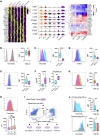Human intraepithelial mast cell differentiation and effector function are directed by TGF-β signaling
- PMID: 39744949
- PMCID: PMC11684804
- DOI: 10.1172/JCI174981
Human intraepithelial mast cell differentiation and effector function are directed by TGF-β signaling
Abstract
Mast cells (MCs) expressing a distinctive protease phenotype (MCTs) selectively expand within the epithelium of human mucosal tissues during type 2 (T2) inflammation. While MCTs are phenotypically distinct from subepithelial MCs (MCTCs), signals driving human MCT differentiation and this subset's contribution to inflammation remain unexplored. Here, we have identified TGF-β as a key driver of the MCT transcriptome in nasal polyps. We found that short-term TGF-β signaling alters MC cell surface receptor expression and partially recapitulated the in vivo MCT transcriptome, while TGF-β signaling during MC differentiation upregulated a larger number of MCT-associated transcripts. TGF-β inhibited the hallmark MCTC proteases chymase and cathepsin G at both the transcript and protein level, allowing selective in vitro differentiation of MCTs for functional study. We identified discrete differences in effector phenotype between in vitro-derived MCTs and MCTCs, with MCTs exhibiting enhanced proinflammatory lipid mediator generation and a distinct cytokine, chemokine, and growth factor production profile in response to both innate and adaptive stimuli, recapitulating functional features of their tissue-associated counterpart MC subsets. Thus, our findings support a role for TGF-β in promoting human MCT differentiation and identified a discrete contribution of this cell type to T2 inflammation.
Keywords: Allergy; Asthma; Immunology; Mast cells.
Conflict of interest statement
Figures






Comment in
- TGF-β drives differentiation of intraepithelial mast cells in inflamed airway mucosa
Similar articles
-
TGF-β drives differentiation of intraepithelial mast cells in inflamed airway mucosa.J Clin Invest. 2025 Jan 2;135(1):e186337. doi: 10.1172/JCI186337. J Clin Invest. 2025. PMID: 39744947 Free PMC article.
-
Human airway mast cells proliferate and acquire distinct inflammation-driven phenotypes during type 2 inflammation.Sci Immunol. 2021 Feb 26;6(56):eabb7221. doi: 10.1126/sciimmunol.abb7221. Sci Immunol. 2021. PMID: 33637594 Free PMC article.
-
Early development and functional properties of tryptase/chymase double-positive mast cells from human pluripotent stem cells.J Mol Cell Biol. 2021 May 7;13(2):104-115. doi: 10.1093/jmcb/mjaa059. J Mol Cell Biol. 2021. PMID: 33125075 Free PMC article.
-
Exploring the origin and regulatory role of mast cells in asthma.Curr Opin Allergy Clin Immunol. 2021 Feb 1;21(1):71-78. doi: 10.1097/ACI.0000000000000703. Curr Opin Allergy Clin Immunol. 2021. PMID: 33369571 Free PMC article. Review.
-
Emerging Roles for MAS-Related G Protein-Coupled Receptor-X2 in Host Defense Peptide, Opioid, and Neuropeptide-Mediated Inflammatory Reactions.Adv Immunol. 2017;136:123-162. doi: 10.1016/bs.ai.2017.06.002. Epub 2017 Jul 24. Adv Immunol. 2017. PMID: 28950944 Review.
Cited by
-
An Autocrine Regulator Loop Involving Tumor Necrosis Factor and Chemokine (C-C motif) Ligand-2 Is Activated by Transforming Growth Factor-β in Rat Basophilic Leukemia-2H3 Mast Cells.Int J Mol Sci. 2025 Apr 30;26(9):4263. doi: 10.3390/ijms26094263. Int J Mol Sci. 2025. PMID: 40362499 Free PMC article.
-
The oesophagus as an immune organ.Nat Rev Gastroenterol Hepatol. 2025 Jun 18. doi: 10.1038/s41575-025-01086-4. Online ahead of print. Nat Rev Gastroenterol Hepatol. 2025. PMID: 40533621 Review.
-
The immunology of asthma.Nat Immunol. 2025 Aug;26(8):1233-1245. doi: 10.1038/s41590-025-02212-9. Epub 2025 Jul 29. Nat Immunol. 2025. PMID: 40730897 Review.
References
MeSH terms
Substances
Grants and funding
LinkOut - more resources
Full Text Sources

